Arroz con gandules is a traditional Puerto Rican dish of tender rice simmered in a broth of spices with pigeon peas and steamed until fluffy and soft. If you’ve ever had the honor of being invited to a Puerto Rican party, you’ve probably seen, if not tasted, Arroz con Gandules. This authentic Puerto Rican rice recipe may become your signature dish and, hopefully, a new part of your family traditions.
*I originally published this recipe in September 2020. I’ve since updated the recipe images and included metric units of measurement.*

Where Is Arroz con Gandules From?
People mistakingly refer to arroz con gandules as “Spanish rice” when it’s actually considered the national dish of Puerto Rico. Rice with pigeon peas is a must at Puerto Rican parties, holiday dinners, and special occasions. We serve it as a side dish with roast pork shoulder (or pernil) or other meats. This flavorful rice dish is served in every Puerto Rican household for parties and large events because you can make a big batch that serves large crowds with minimal effort.
Other Caribbean islands, namely those with an Indian influence, have their own arroz con gandules recipe, albeit with some fundamental changes in the preparation. The Dominican Republic has moro de guandules and Trinidad and Tobago has pelau. Some nations have different ways of preparing the dish; Jamaica, for example, serves a lighter (in color) version of arroz con gandules, which they call rice with gungo peas.
What Ingredients Do I Need To Make It?
To make this classic Puerto Rican rice, you need rice, olive oil, pork (or one of your favorite proteins), gandules, tomato sauce, sofrito, capers, olives, chicken bouillon (or chicken broth), Adobo, garlic powder, oregano leaves, sazón, onion powder, and black pepper. You’ll also need water (unless you’re using the chicken broth).
You can use store-bought sofrito for this recipe, but my homemade sofrito recipe is pretty amazing.
What Are Gandules From?
Gandules, pronounced gahn-DOO-lays, means “pigeon peas” in the Puerto Rican dialect. They do not come from pigeons, but their name comes from the fact that they were (are) a popular food source for the island’s pigeons.
The pigeon pea is a large part of the Indian diet, where it originated because it’s such a great source of fiber and protein. It was more than likely carried to West Africa on the same slave ships that brought our West African ancestors to Puerto Rico and the Caribbean islands.
Pigeon peas are legumes, like lentils or sweet green peas. Fresh gandules are bright green and tender enough to eat raw. Canned or dry pigeon peas can take on a muted brown color, but they’re also sold as green pigeon peas.
After you open the can of gandules, strain the liquid into the measured cooking water.
What Kind Of Rice Do I Make Arroz con Gandules With?
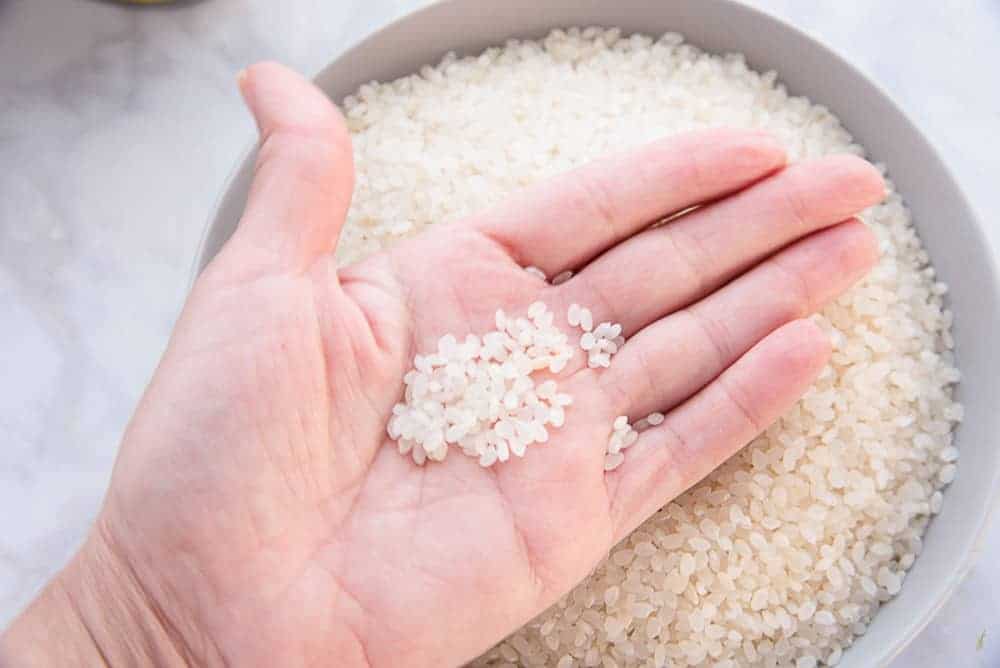
I started making my arroz con gandules with long or extra-long grain rice because it was hard to find medium when the Army moved us. Now, it’s the only rice I use. You can stick with medium-grain rice or replace the long-grain with basmati or jasmine rice. If you use brown rice to make arroz con gandules, soak the grains for 30 minutes before you cook with it.
A very important step to prevent the arroz con gandules from being mushy is to rinse excess starch off the rice before you cook it. Rinse the rice a couple times under cold, running water until the water runs clear. It usually takes me 3 times before my water is clear. Drain the rice of excess water while you prep your ingredients.
What’s The Best Pot To Use?
A caldero, pronounced call-de-row and translates to “cauldron,” is the most popular type of pot to use when making arroz con gandules. Calderos are another staple in Puerto Rican recipes. Imusa calderos are the most popular brand of pots in Puerto Rican kitchens.
That said, you don’t have to use one if you don’t have one. You can use a well-seasoned cast iron or ceramic-coated dutch oven to make arroz con gandules. Just cook it in a heavy-bottomed pot so you don’t scorch your arroz con gandules.
Does Arroz con Gandules Always Have Meat In It?
I make my arroz con gandules with bite-size pieces of pork. Pork chops (pork loin chops) are the best cut for this recipe since they are tender and cook quickly. Diced pork belly is another great option. You can replace the pork with salt pork (or tocino), another commonly used meat. If you’re not into rice with meat chunks, sauté the rice in 1/4 cup of bacon drippings. Decrease the adobo seasoning to 2 teaspoons since tocino and bacon are saltier than pork chops.
You can also substitute pork skin on chicken thighs for the pork. Skin-on chicken thighs are better because you can render the fat from them, which adds flavor to your rice. When made with meat, arroz con gandules can be its own meal.
Combine the spices in a small bowl and remove a tablespoon to season the meat. Season the meat for at least 30 minutes before cooking the rice or for up to 24 hours for a more flavorful dish.
To make vegan arroz con gandules, omit the meat, sauté the rice in extra virgin olive oil, and replace the chicken stock with vegetable stock or water.
Brown the seasoned meat quickly over medium-high heat in a tablespoon of olive oil.
Some people use achiote oil from annatto seeds simmered in oil to make their arroz con gandules. Because I use sazón seasoning and tomato sauce, I don’t always use it in my rice since both add color to the rice. You can sauté your meat in the achiote oil if you have some made.
How Do I Avoid Mushy Rice?
The most common reasons arroz con gandules turns out mushy are not toasting the rice before the water is added, adding too much water to the pot, stirring the rice too much, and improper steaming.
Sautéing the rice grains in the olive oil and fat rendered from the pork for about 2-3 minutes keeps the grains separated and adds a mildly nutty flavor to the rice.
After toasting the rice for 2-3 minutes over medium-high heat, add the sofrito to the pot. The sofrito’s culantro helps give this recipe its authentic flavor. You can use sofrito straight from the freezer, as I do, or use fresh sofrito if you have that.
Sauté the sofrito for 2 minutes regardless if it’s fresh or frozen.
Add the tomato sauce, the remaining spice blend, and the water mixture to the rice in the pot. Give everything a good stir. Make sure to mix the rice and liquids completely.
You can omit the tomato sauce in this recipe if you prefer. I add it to give the rice flavor and color. Replace the tomato sauce with the same amount of water.
Next, add the capers, olives, and chicken bouillon paste to the pot.
Finally, stir the drained gandules into the rice and bring the liquid in the pot up to a gentle boil.
How Long Do I Cook Arroz con Gandules?
Arroz con gandules takes about 40 minutes to cook from start to finish.
Allow the water to boil until the surface of the rice peeks through, which can take anywhere from 8-10 minutes. You’ll know to move on to steaming when the water in the caldero evaporates and reveals the top layer of arroz con gandules through the bubbling liquid.
Fold the rice from the outside into the center using a large spoon once most of the water evaporates. It will sound like rustling newspapers when you fold it. Spread the rice into an even layer in the pot, reduce the heat to low, and lay a square of aluminum foil or a banana leaf over the pot.
Press the pot lid firmly onto the foil to create a tight seal between the lid and the pot. Trapping the steam in the caldero cooks the rice more effectively.
Steam the rice for 20 minutes over medium-low to low heat without lifting the lid. Allow the arroz con gandules to steam undisturbed or it may come out hard. Don’t stir it; you’ll kick up the starches, and the rice will come out mushy. Leave it alone throughout this cooking time.
After 20 minutes, remove the lid with the foil and fold the rice from the outside to the inside of the pot again. Return the lid to the pot, turn the heat off, and leave it on the burner until it’s time to serve.
If the arroz con gandules is still hard after 20 minutes of steaming, add 1/4 cup of water, seal it with the lid and foil, and steam for 10 minutes over low heat.
If the rice is mushy and clumps together, cook it uncovered for 10 minutes on low to dry out.
How Do Serve It?
Serve arroz con gandules like Puerto Ricans do, with fried chuletas, pernil, or chicken and a garden salad.
Fluff it up with a fork or spoon before serving the rice. Scoop the fluffy rice onto your plates (or bowls) and dig in.
Again, arroz con gandules is a meal in and of itself, so you can eat it as a main dish or a side. Top a serving with a fried egg and eat it for breakfast.
Don’t forget to scrape down to the crunchy bits on the bottom of the caldero! Pegao is the crispy rice on the bottom of a pot of cooked rice, and it’s considered a delicacy. All the flavor concentrates in those crunchy bits of rice on the bottom. People either love it or hate it. I love it.
How Do I Store Leftovers?

Store leftover arroz con gandules in an airtight container in the fridge for 3 days. To reheat it, add a tablespoon or two of cold water to the rice and microwave it on high for 2 minutes, stirring halfway through the reheating time. You can also reheat it in a non-stick skillet until warm.
To freeze leftover arroz con gandules, allow it to cool completely, then transfer it to a freezer bag and freeze it for 6 months. Thaw the rice overnight in the refrigerator and reheat it in the microwave after sprinkling water over the rice.
Arroz con Gandules is undoubtedly Puerto Rico’s national dish and one of its most delicious recipes. If this is your first time making and tasting it, let me know your thoughts in the comments below.
Don’t forget to pin this recipe to your side dishes board and share it with your friends and family. And for a more in-depth version, check out this video on YouTube.
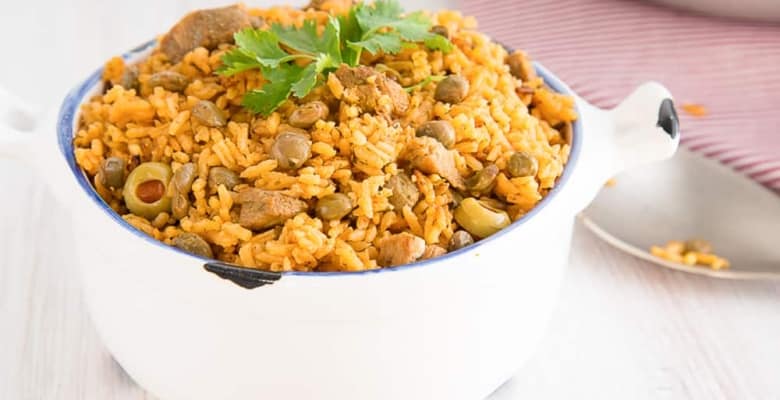
Arroz con Gandules (Puerto Rican Rice with Pigeon Peas
at Sense & EdibilityEquipment
- 5qt caldero or dutch oven
Ingredients
Spice Blend
- 1 tablespoon (15 grams) Adobo (or 1-2 teaspoons for low sodium option)
- 2 1/2 teaspoons (10 grams or 2 packets) Sazón con achiote
- 2 teaspoons (6 grams) onion powder
- 2 teaspoons (6 grams) granulated garlic
- 1 teaspoon dried oregano leaves
- 3/4 teaspoon (3 grams) black pepper
For the Arroz con Gandules
- 1 cup (2 small or 200-300 grams) pork chops* cut into small chunks
- 1/4 cup (60 milliliters) extra virgin olive oil or achiote oil (see post)
- 3 cups (655 grams) long grain rice rinsed 3-4 times in cold water
- 1/2 cup (130 grams) sofrito
- 1/2 cup (120 milliliters or 4 ounces) tomato sauce
- 6 manzanilla olives pitted
- 1 teaspoon capers
- 1 teaspoon (8 grams) chicken bouillon base (or vegetable base), optional
- 2 cups water plus liquid strained from gandules
- 15.5 ounce can (439 grams) gandules (pigeon peas) (strain liquid from can into the water for boiling)
- kosher salt or adobo to taste
Instructions
Make the spice blend and season the meat (Can be done a day ahead)
- In a small bowl, combine the adobo, sazón, onion powder, granulated garlic, oregano, and black pepper. Stir together to combine well.
- In a mixing bowl, sprinkle 1 heaping teaspoon of the spice blend onto the chunks of pork. Toss to coat the meat in the spice blend and allow the seasoning to penetrate the meat for 30 minutes to 24 hours. Reserve the remaining spice blend for seasoning the rice.
Prepare the Arroz con Gandules
- Heat the olive oil over medium-high heat in a 5-quart caldero (or heavy bottom dutch oven).When the oil begins to shimmer, add the seasoned pork chunks to the pot. Quickly brown the pork stirring frequently with a large spoon. Cook the pork for 3-4 minutes, or just until it begins to brown.
- Stir the rinsed rice into the pot with the meat and sauté the grains of rice in the fat rendered from the pork and the olive oil. Toss the rice frequently as it toasts, and sauté for 2-3 minutes over medium-high heat, or until the grains of rice look glossy.
- Add the sofrito to the pot. Sauté the sofrito for 2 minutes making sure to scrape the bottom of the caldero to keep the rice from sticking too much. (If you're using frozen sofrito, don't worry if it's not thawed completely at the end of this cooking time, it will continue to thaw as the rice cooks).
- If the rice is beginning to stick or burn on the bottom of the pan, lower the heat to medium. Add the tomato sauce, the remaining spice blend, the water and reserved liquid from the gandules to the pot. Stir to make sure the rice and liquids are combined well.
- Lastly, add the olives, capers, chicken base, and the drained gandules. Stir everything well to incorporate it into the rice mixture.Finally, bring the water in the pot up to a boil.
Boil, then Steam the Rice
- Allow the water boil until the surface of the rice peeks through: this can take anywhere from 8-10 minutes over medium to medium-high heat.Once the water has evaporated, and the top layer of rice peeks through the bubbling liquid, fold the rice from the outside of the pot to the center- all around the pot.
- Spread the rice back into an even layer in the pot and reduce the cooking heat to low.Lay a square piece of aluminum foil, wide enough to overlap the sides- over the pot. Press the lid of the pot firmly onto the foil, sandwiching it between the pot and the lid, to create a tight seal which steams the rice more effectively.
- Steam the rice for 20 minutes over low heat. Don't lift the lid until the 20 minutes of cooking time is finished. After 20 minutes, fold the rice from the outside to the inside of the pot once again. Give it a little taste. The rice should be soft and tender.
- If the rice is still hard after 20 minutes of steaming, pour in 1/4 cup of water and seal it again with the lid and foil. Steam for an additional 10 minutes over low heat. If, on the other hand, the rice is mushy and clumps together, continue to cook it, uncovered, for another 10 minutes to dry it out a bit.
- Once the rice is cooked, replace the lid, turn off the burner, and leave the pot to sit on the warm burner until ready to serve it. When you're ready to serve, scoop the rice and dish it out. Serve as an entree with a side salad or as a side dish.
Notes
To thaw the rice, just pop it into the fridge overnight. Reheat it in the microwave after sprinkling a little water over the rice. Try these swaps:
Make it vegetarian:
- omit the seasoned pork AND
- replace the chicken bouillon with vegetable base
Swap the meat:
- use seasoned, skin-on, chicken thighs instead of pork
- use seasoned chunks of beef chuck
- cut Vienna sausage or canned ham into chunks (don't season these as they are already salty)
Switch up the simmering liquid:
- use coconut water instead of water
- simmer in half water-half beer
- simmer in pork or beef stock instead of chicken stock

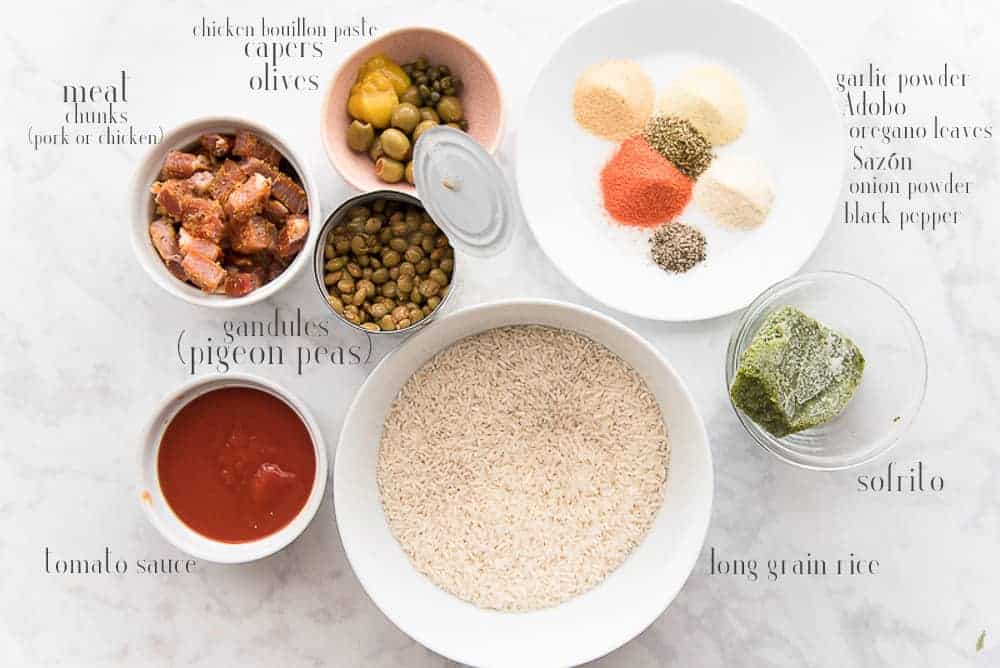
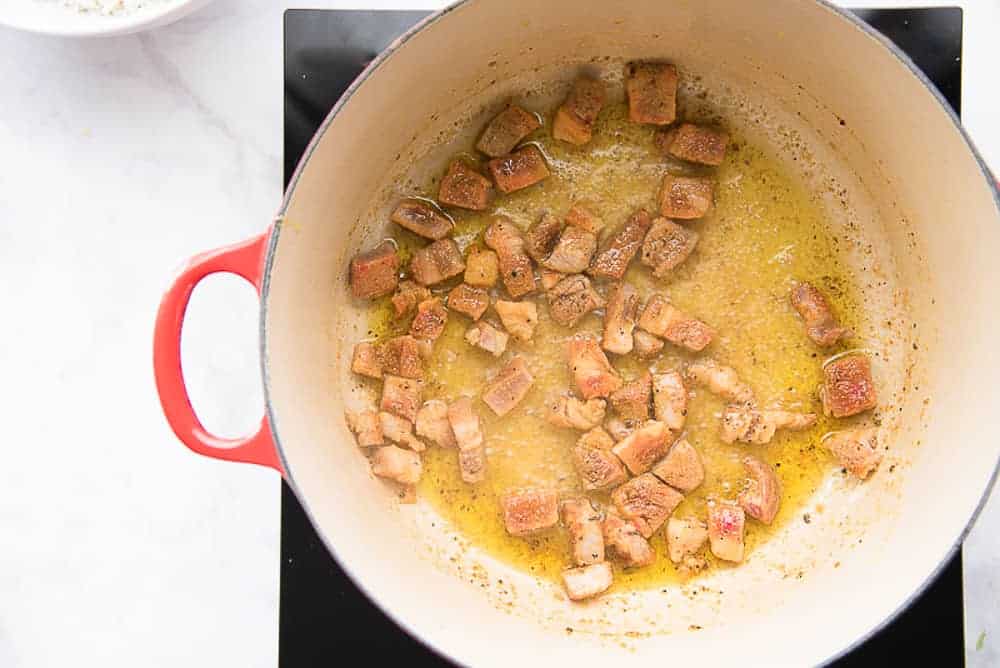
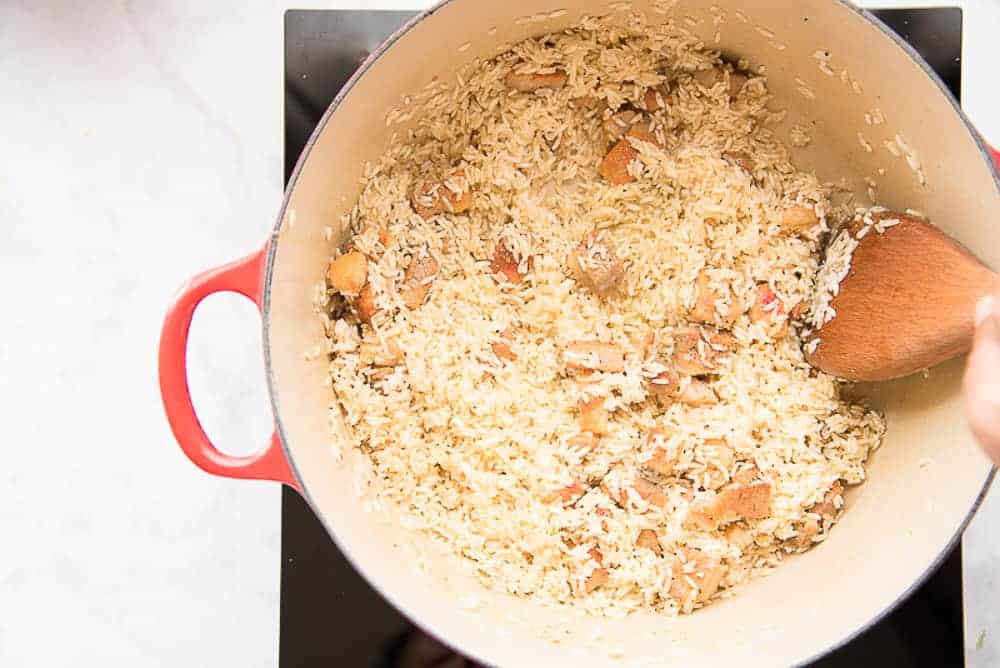
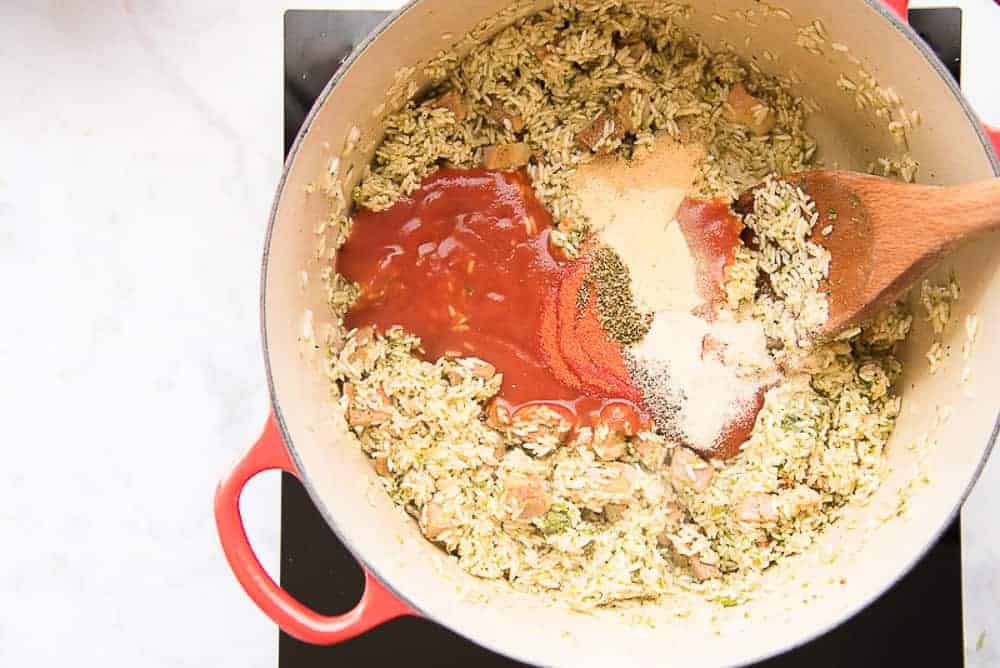
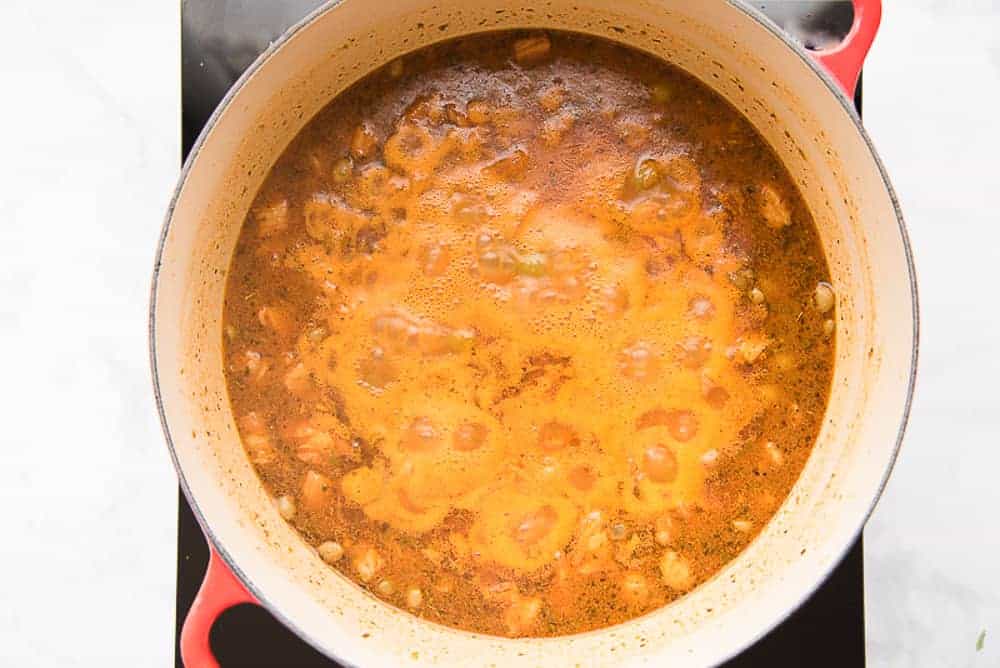
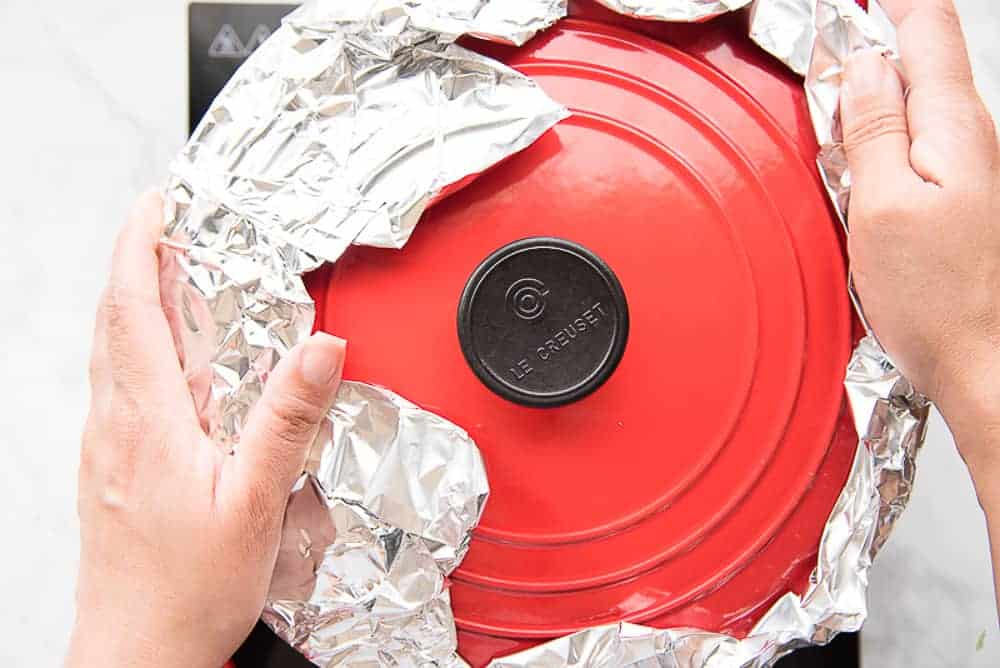
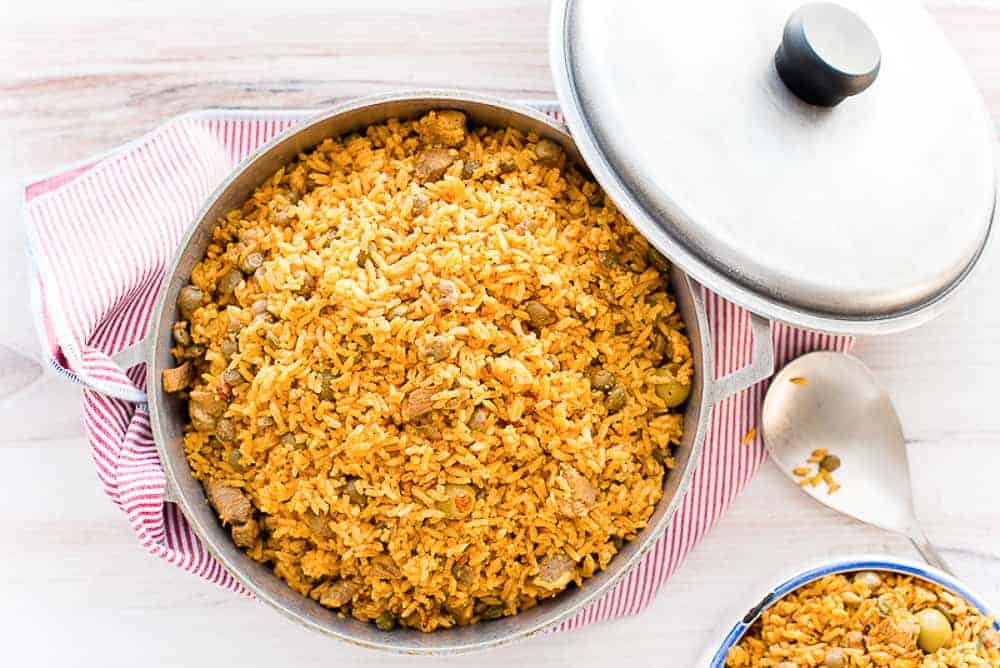






What is the serving size used for the nutritional info?
The nutrition info is for 12 1/2 cup servings, but we’re super greedy in my family. So you can serve less rice person person if you need to, but 1/2 cup cooked rice is the recommended serving size.